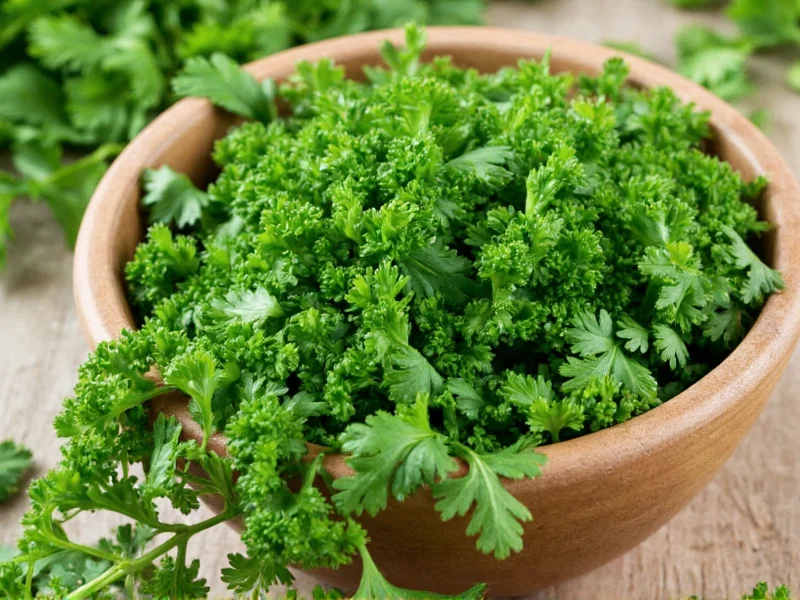Understanding herb conversions is essential for consistent cooking results. When substituting dried parsley for fresh in recipes, getting the measurements right prevents under-seasoned or overpowering dishes. This guide provides precise conversion information backed by culinary science, helping both home cooks and professional chefs achieve perfect flavor balance.
Why Fresh and Dried Parsley Require Conversion
Fresh parsley contains approximately 85-90% water, while dried parsley has most moisture removed. This dehydration process concentrates the essential oils and flavor compounds, making dried parsley significantly more potent by volume. The 3:1 ratio (fresh to dry) compensates for this concentration difference.
The Science Behind Herb Conversion Ratios
When herbs dry, they lose water content but retain most flavor compounds. Fresh parsley's high water content dilutes its flavor profile. During drying, volatile oils become more concentrated as water evaporates. This scientific principle applies to most leafy herbs, though exact ratios vary slightly by herb type.
Parsley Fresh to Dry Conversion Chart
| Measurement | Fresh Parsley | Dried Parsley |
|---|---|---|
| Teaspoon | 3 tsp | 1 tsp |
| Tablespoon | 1 tbsp | 1/3 tbsp (1 tsp) |
| Cup | 1 cup | 1/3 cup |
| Ounce | 1 oz | 1/3 oz |
Practical Application in Recipes
When adapting recipes that call for fresh parsley, use this conversion method: divide the fresh measurement by three to determine the dried equivalent. For example, if a recipe requires 2 tablespoons fresh parsley, use 2 teaspoons dried parsley instead.
Chefs recommend adding dried herbs earlier in the cooking process than fresh herbs. Dried parsley needs time to rehydrate and release its flavors, while fresh parsley is typically added near the end to preserve its bright flavor and color.
Flavor Profile Differences
Fresh parsley offers a bright, grassy flavor with subtle peppery notes, while dried parsley develops a more earthy, concentrated taste. The drying process alters some volatile compounds, resulting in slightly different flavor profiles. Culinary experts note that dried parsley works better in long-simmered dishes like soups and stews, while fresh parsley shines in finishing applications like garnishes and fresh sauces.
Storage Recommendations for Optimal Freshness
Proper storage affects both forms' potency and conversion accuracy:
- Fresh parsley: Store upright in a glass with water (like flowers), covered with a plastic bag in the refrigerator. Lasts 1-2 weeks.
- Dried parsley: Keep in an airtight container away from light and heat. Properly stored, it maintains potency for 1-2 years.
Older dried herbs lose potency, so you might need to increase the amount slightly for older spices. Always check dried herbs for strong aroma before using—if the scent is faint, replace your supply.
When to Choose Fresh vs. Dried Parsley
Understanding when to use each form improves your cooking results:
- Use fresh parsley for: Garnishes, tabbouleh, chimichurri, fresh salads, and any dish where visual appeal matters
- Use dried parsley for: Soups, stews, marinades, spice blends, and recipes with long cooking times
Professional chefs often combine both forms in complex dishes—using dried for foundational flavor and fresh for finishing touches. This technique maximizes flavor depth while maintaining visual appeal.
Common Conversion Mistakes to Avoid
Cooks frequently make these errors when substituting parsley forms:
- Using equal measurements (1:1 ratio) instead of the proper 3:1 conversion
- Adding dried parsley too late in the cooking process
- Using old, stale dried herbs that have lost potency
- Not adjusting for recipe moisture content (drier recipes may need slightly more)
Remember that conversion ratios serve as starting points. Always taste and adjust seasonings as you cook, as individual palates and recipe variables affect the ideal amount.
Expert Tips for Perfect Herb Substitutions
Professional chefs recommend these advanced techniques:
- Rehydrate dried parsley in a small amount of warm water or broth before adding to dishes for more even flavor distribution
- For critical recipes, make a small test batch with your converted measurements before preparing the full dish
- Consider the recipe's final texture—dried parsley can create small dark specks in light-colored sauces
- When in doubt, start with less dried parsley and add more as needed—you can always add more, but you can't remove excess
What is the exact conversion for fresh parsley to dried parsley?
The precise conversion ratio is 3:1—3 parts fresh parsley equals 1 part dried parsley. Specifically, 1 tablespoon fresh parsley equals 1 teaspoon dried parsley. This accounts for the moisture loss during drying that concentrates the flavor compounds in dried herbs.
Can I substitute dried parsley for fresh in all recipes?
While you can substitute dried parsley for fresh in most recipes, the results vary by dish type. Dried parsley works well in cooked dishes like soups, stews, and sauces where it has time to rehydrate. However, for raw applications like salads, garnishes, or fresh sauces, fresh parsley provides superior flavor and texture that dried cannot replicate.
How does the flavor differ between fresh and dried parsley?
Fresh parsley has a bright, grassy flavor with subtle peppery notes and higher moisture content. Dried parsley develops a more earthy, concentrated flavor profile as the drying process alters some volatile compounds. The fresh version works better for finishing dishes, while dried provides foundational flavor in cooked preparations.
Does the conversion ratio change for different parsley varieties?
The standard 3:1 conversion applies to both curly and flat-leaf (Italian) parsley varieties. However, flat-leaf parsley generally has slightly stronger flavor than curly, so some chefs use a 2.5:1 ratio for flat-leaf when precision matters. For most home cooking applications, the standard 3:1 ratio works well for both varieties.
How should I adjust recipes when using older dried parsley?
Older dried parsley loses potency over time. If your dried parsley is more than 6 months old, increase the amount by 25-50% beyond the standard conversion. Always check dried herbs for strong aroma before using—if the scent is faint when you crush a pinch between your fingers, replace your supply for best results.











 浙公网安备
33010002000092号
浙公网安备
33010002000092号 浙B2-20120091-4
浙B2-20120091-4